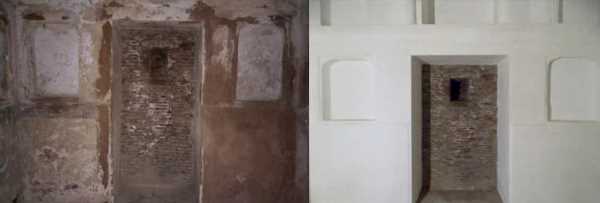Amid the controversy over the 22 locked rooms in the basement of the Taj Mahal, the Archaeological Survey of India has released some photographs of closed underground cells.
The images show two spots inside the underground rooms of the Taj Mahal where maintenance work was carried out recently.
“The work of maintenance of underground cells on the river side was taken up. Decayed and disintegrated lime plaster was removed and replaced by laying of lime plaster and traditional lime processing before application,” the January 2022 newsletter from the Archaeological Survey of India said, along with four photographs of the basement cells.
Repairs were also carried out on the gateways located in the Tajganj area and around the Taj Mahal.
The grand double arched gateways — Katra Umar Khan Gate, Katra Resham Gate, Katra Fulel Gate, Dakhani Darwaza — are one of the few original remnants of the settlement of Tajganj.
“The work of removal of old and decayed lime plaster and lakhauri bricks was done with the new one. For repairs roof of the Katra Fulel Gate was opened and old decayed lime mortar, etc. was removed and replaced with the new one,” reads the 20th page of the January 2022 newsletter of the Archaeological Survey of India.
On May 12, the Lucknow bench of the Allahabad high court dismissed a plea seeking a ”fact-finding inquiry” into the history of the Taj Mahal and the “opening of 22 rooms” on the monument’s premises, saying the petitioner failed to point out which of his legal or constitutional rights were being infringed.
There is no clarity if the photographs released by the ASI were part of these 22 rooms.
The Lucknow bench of justices DK Upadhyay and Subhash Vidyarthi pulled up the lawyer of petitioner Rajneesh Singh, who is the media in-charge of the BJP’s Ayodhya unit, for filing the PIL in a “casual” manner and said it cannot pass an order under Article 226 of the Constitution in the matter.
The writ petition was filed by Rajneesh Singh to seek a fact-finding inquiry into the history of the Taj Mahal and sought opening of the doors of its “22 rooms” to see “the truth, whatever it is”.
Several Hindu right-wing outfits have claimed in the past that the Taj Mahal was actually Tejo Mahalaya, a temple of Lord Shiva.
The monument is protected by the Archaeological Survey of India.
Source: Read Full Article


